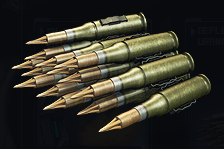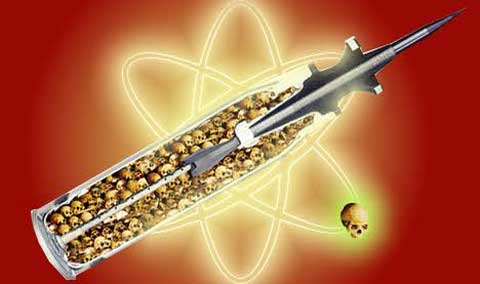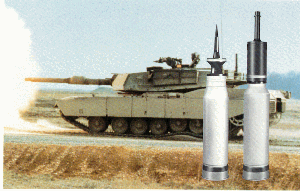
An Urgent Appeal to the
G7 Hiroshima Summit (May 19-21, 2023)
By the Citizens’ Network Opposing the Use of DU Weapons in Ukraine
(April 25, 2023) — Deeply concerned about the grave situation created by the war in Ukraine, we, the undersigned, feel an unprecedented sense of crisis. With nuclear plants in the line of fire and frequent threats to use nuclear weapons, we feel catastrophe looming ever closer. In this context, we hear that depleted uranium (DU) ammunitions are being delivered to Ukraine by the UK.
DU munitions are made of nuclear waste. If used in Ukraine, many Ukrainians will be harmed and the natural environment will likely be irreparably contaminated. Thus, while hoping above all for a prompt end to the war, we demand that the countries involved in the G7 Hiroshima Summit take the following actions:
1) Japan, the host of the G7 Hiroshima Summit, should issue emphatic appeals at the G7 Summit regarding the inhumanity of both DU and nuclear weapons, arousing international public opposition to the use of these weapons in Ukraine.
2) The UK should halt delivery of DU munitions to Ukraine and withdraw immediately those already delivered.
3) If the Russian military has already used DU munitions in Ukraine, the danger of which Russia itself has admitted, they should disclose the locations where they have used them. It should do its utmost to repair the damage, cooperating with efforts to help the natural environment recovery.
4) Ukraine should refuse to use the DU ammunitions supplied by the UK. DU munitions will, in all likelihood, harm the health of Ukrainian soldiers and people, and the contamination will make postwar recovery even more difficult.

ACTION:
Don’t Contaminate Ukrainian Soil with DU
Sign here. Please endorse this appeal, Don’t Contaminate Ukrainian Soil with Depleted Uranium Weapons, at Change.org (https://chng.it/9w4Dg5drhm by May 7, 2023 —though your signatures will be appreciated even after this date. By signing, you will strengthen our efforts to highlight this issue prior to and during the G7 Hiroshima Summit to be held May 19-21 in Hiroshima.
We will try our best to draw the attention of the G7 leaders and the hundreds of journalists who will gather from around Japan and the world to this urgent and global issue.
This appeal follows the “Statement against the delivery of depleted uranium munitions to Ukraine by the British Government” delivered to the UK ambassador to Japan on April 12, 2023, and its content is based on the appeal issued by HANWA (Hiroshima Alliance for Nuclear Weapons Abolition) on March 27, 2023. Both of these appeals are uploaded at the online signature site for this appeal. Contact: hibakushaforum@gmail.com

Grounds for the Appeal: Lies About DU
On March 20, British Minister of State for Defence Annabel Goldie admitted that the Challenger 2 battle tanks the UK plans to send to Ukraine are equipped with DU (depleted uranium) armor-piercing rounds. In response, Russian President Putin stated that Russia would “respond accordingly.” Defence Minister Shoigu referred to the possibility of “a nuclear collision,” and Russia followed up by announcing a plan to deploy “tactical nuclear weapons” in Belarus. This announcement has further raised tensions around the world.
However, Explosive Ordnance Guide for Ukraine, Geneva International Center for Humanitarian Demining) lists DU rounds (“3BM32 Vant”) among the weapons provided by Russia to its own armies in Ukraine.1 Thus, Russia’s reaction is the height of deception and further evidence of the egregious inhumanity of Russia’s military actions in Ukraine.
On the other hand, the statements made by the UK and the USA. also contain grave deceptions. They argue that DU is a “standard component” of conventional ammunitions in use for a few decades now. But this does not mean that DU is not a problem; the reality is completely opposite. Such denial of the risk can be made only because they are disregarding, or ignorant of, the scientific findings to the contrary and the voices of the victims suffering DU damage, particularly Iraqis, particularly children, as well as the soldiers of various countries who served in Iraq and the former Yugoslavia.2

What Are DU Rounds?
Although DU rounds are not “nuclear weapons, they are produced by military recycling of radioactive wastes (DU=depleted uranium). DU is U-238 left behind after the enrichment process that produces “fissionable uranium 235” needed for nuclear weapons and nuclear power generation. The penetrator of a 30 mm DU round is said to contain about 300 grams of DU.3
DU is not “fissionable,” but it is radioactive with strong chemical toxicity. Consequently, wherever DU rounds are used, whether on battlefields or on firing ranges, and even if they miss the target and get stuck in land,4 they can cause a wide variety of long-term harms to human bodies and environments.5

DU Risk: Denied and Confirmed
DU is considered a possible cause of the increased childhood cancer, leukemia, and congenital deformities in Iraq where large amounts of DU were dispersed during the Gulf War and the Iraq War.6 Many of the soldiers (from US, UK and elsewhere) who fought in these wars suffered the so-called “Gulf War Syndrome,” which caused heated international controversy. DU is also a suspected cause of the “Balkan Syndrome” suffered by European soldiers who were sent to the former Yugoslavia for the PKO mission in 1999 after the conflict there. Especially in Italy, lawsuits were initiated by the suffering soldiers and their families.7
In providing DU rounds to Ukraine, the U.K. is downplaying the toxicity of DU, but the U.K. is clearly aware of that danger. We learned in 2004 that the U.K. Army was issuing to its own soldiers deployed in Iraq the “DU Information Card” shown below to alert them to the risk of exposure to DU in Iraq.8
Most significantly, as has been widely reported, UNEP (the United Nations Environment Plan) points out in its 2022 report, The Environmental Impact of the Conflict in Ukraine: A Preliminary Review: “Depleted uranium and toxic substances in common explosives can cause skin irritation, kidney failure and increase the risks of cancer.”9
In addition, the international community should consider seriously the conclusion that “the placenta is not a barrier to DU migration,” which was drawn from an animal experiment conducted by AFRRI (U.S. Armed Forces Radiological Research Institute) around the time of the Iraq War.10
%20(1).jpg?itok=Jd36JBr2)
International Actions Promoting
the Prohibition of DU Weapons
ICBUW (International Coalition to Ban Uranium Weapons) was launched in October 2003 to establish an international ban on DU weapons.11 On March 22, 2007, a bill to prohibit DU rounds was adopted unanimously in the Belgian Parliament.12 In May 2009, the European Parliament adopted by an overwhelming majority a resolution calling for concrete actions toward the prohibition of DU weapons. In addition, the UN has been adopting a resolution that alerts the international community to the DU problem almost every other year since 2007.13
On the military side, it is now known that the U.S. army plans to phase out DU rounds by November 2026.14 This move is evidence that the U.S. military has come to understand that they can no longer ignore international public opinion and the campaign to ban DU rounds.

Birth deformaties resulting from exposure to DU weapons.
Appealing Again from Hiroshima
In March 2003, the human message, “NO WAR NO DU!” was formed by about six thousand people standing in Hiroshima’s Central Park. That event was an expression of vehement protest against the imminent attack on Iraq and the likely use there of DU rounds. On March 24 a half-page ad featuring an aerial photo of the “NO WAR NO DU!” appeal (shown below) was carried in The New York Times.15
We deeply regret that Hiroshima has to send that same message again, twenty years later. Although the target of international blame has shifted from the USA and its invasion of Iraq to Russia and its invasion to Ukraine, the danger of DU weapons remains obscured by the deceptive rhetoric of politicians and militaries.
The international community must recognize DU rounds as “inhumane weapons” that cause human suffering extending far beyond the battlefields in time and space. All nations should cooperate with and accelerate the effort to eliminate DU together with nuclear weapons.

Footnotes
1 “ICBUW Statement on British DU Ammunition to Ukraine, ”March 22, 2023. (https://www.icbuw.eu/en/). Cf. Explosive Ordnance Guide for Ukraine, 2nd edition, 2022, GICHD, p.109 (https://bit.ly/3ZfI0TS).
See also “Depleted Uranium Weapons: State of Affairs 2022 (ICBUW, July 3, 2022), which states that “Russia has a significant number of different DU-rounds in its arsenals. There are reports of mass production of the improved Svinets-1 and Svintes-2 depleted uranium ammunition…. It seems that Russia didn’t abandon its DU programme, but on the contrary – it has increased production volumes and is actively modernizing outdated tanks to make them capable of firing DU ammunition.”
Furthermore, the above-mentioned ICBUW Statement states: “According to media reports [in Russia], Russian forces in Ukraine have also recently received the more modern 3BM60 “Svinets-2” ammunition” (https://bit.ly/3KrHQVu).
2 Similar critical views are presented in recent reports in the media. See “Ukraine war: UK defends sending depleted uranium rounds after Putin warning” (BBC, March 22); “A look at the uranium-based ammo the UK will send to Ukraine (The Washington Post, March 23); “What are the depleted uranium munitions the UK is sending to Ukraine? (ALJAZEERA, March 23).
3 Such military reuse of DU was devised to dispose of the enormous and increasing amount of “depleted uranium” accumulated through nuclear exploitation. DU rounds are considered “ideal” both economically and militarily; DU is provided almost for free to military industries, and DU rounds are so powerful that they render conventional tanks almost useless. (Because DU alloys can be much harder than steel and denser than lead, they are used in anti-tank penetrators and tank-armour as well.)
However, DU burns on impact, turning into minute particles, which are scattered through the area. The term ”depleted” is intended to cover up the danger DU poses, giving a misleading impression as if the substance were “depleted” of radioactivity and chemical toxicity. We use the term here because it is commonly understood, but we hope the problem hidden by that name will be kept in mind.
There are many books, articles and documentaries on the danger of DU weapons; just to mention a few available in English, Metal of Dishonor—Depleted Uranium: How the Pentagon Radiates Soldiers & Civilians with DU Weapons (1997) by John Catalinotto and Sara Flounders; Discounted Casualties: The Human Cost of Depleted Uranium (2001) by Akira Tashiro; Poison DUst (2005; 84 min.) directed by Sue Harris; Uranium 238: The Pentagon’s Dirty Pool (2009; 28 min.) directed by Pablo Ortega.
4 DU contamination has caused serious problems near firing ranges around the world, such as those in New Mexico
(U.S.), Scotland (U.K.), Sardinia (NATO), and Maehyang-ri in South Korea (U.S.) as well as around the production facility that operated for years in upper New York State.
Controversy arose also in Japan when it was learned that U.S. forces fired 1, 520 DU rounds to strike Torishima Island near Okinawa in 1995-96.
Heated debates were triggered in the Japanese National Diet when it was reported in November 2003 that strong radiation was detected coming from remnants in Samawah in southern Iraq, where Japan was planning to send its Self-Defense Forces for “humanitarian assistance in reconstruction.” SDF soldiers risked exposure to radiation due to DU. The troops ended up carrying Geiger counters during their deployment there. See, “Depleted uranium said polluting Samawah,” The Japan Times, Nov. 22, 2003 (https://bit.ly/3ohcEiS).
5 According to an official statement by the U.S. forces, more than one million DU rounds were used in the Gulf War and about 320 tons of DU was contained in these penetrators. It is estimated that about half that amount was expended in the Iraq War. In a word, enormous amounts of radioactive waste have been dispersed into the environment. The use of DU reveals a blatant double-standard on the part of the users because such use would constitute an illegal and criminal act if carried out on the army’s homeland.
Regarding the effects of DU on human health and the environment in Iraq, see, for instance, Dr. Jawad Al-Ali’s report in “Iraqi Doctors in Hiroshima” and Haruko Moritaki’s report, “What hath the United States wrought in Iraq? Hiroshima Emergency Survey Report on DU and War Damage in Iraq (2003.6.22-7.5)” included in Hiroshima Appeal for Banning DU Weapons (NO DU Hiroshima Project, Oct. 2003). Both of these reports are based on investigations into increased incidence of malignant tumors, contamination of soil and underground water, and high levels of uranium detected in the urine of children patients.
6 In May 2009 the First International Cancer Conference was held to address the question of increased cancers in the southern city of Basra, sight of one of the most violent and extended battlefields in the two wars.
7 In June 2004 the court in Rome ordered the Italian Ministry of Defense to pay 500, 000 euro to the family of Stefano Melone, who served in the Balkans and died of multiple cancers.
Furthermore, in May 2019 Italian Minister of Defense Elisabetta Trenta announced her decision that the soldiers who suffered serious disease after serving in the Balkans should be entitled to compensation even if a conclusive link could not be made. See ”Italy’s defense minister backs link between cancer in military personnel and exposure to toxic uranium,” DefenseNews, May 31,2019 (https://bit.ly/3AdoJby) .
This article states: “In recent years, 366 Italian military personnel have died, and 7,500 have taken sick with conditions potentially linked to depleted uranium, prompting courts in Italy to demand compensation, despite denials from military officials that any link existed.”
8 Ray Bristow, “The Deception by the U.K. Government Continues: The Gulf War, the Balkans, and the Iraq War,” included in Seeking a World without Uranium Weapons 2009, in Japanese).
9 “Ukraine war: UK defends sending depleted uranium rounds after Putin warning,” BBC, March 22, 2023 (https://www.bbc.com/news/world-europe-65032671).
Cf. The Environmental Impact of the Conflict in Ukraine: A Preliminary Review, UNEP, October 14, 2022 (https://www.unep.org/resources/report/environmental-impact-conflict-ukraine-preliminary-review).
10 Cf. “Depleted Uranium: Scientific Basis for Assessing Risk,” Nuclear Policy Research Institute, July, 2003, p.15. (https://www.helencaldicott.com/depleted.pdf).
11 For ICBUW campaign details, please visit its homepage at https://www.icbuw.eu/en/.
12 This bill prohibits the production, storage, provision, delivery and use of DU rounds as well as tank-armour
containing DU inside Belgium. It was the world’s first domestic law banning DU weapons based on the
“precautionary principle.” Costa Rica followed by adopting a similar bill on April 27, 2011.
13 There are only four countries that have been opposing the resolution; they are U.S., U.K., France, and Israel. Russian has been abstaining. For more detail, see https://www.icbuw.eu/en/
Among the countries confirmed to have produced DU munitions are: U.S.A., U.K., France, Russia, China, India, Pakistan, Serbia. (U.K. ceased producing large caliber ammunition in 2003.) The countries confirmed to have possessed DU munitions are: Israel, Greece, Turkey, Saudi Arabia, Bahrain, Egypt, Kuwait, Thai, and Taiwan in addition to the producing countries mentioned above. However, it has not been confirmed which countries still possess or have discarded DU munitions.
14 See “ICBUW Statement on British DU Ammunition for Ukraine” (March 23, 2023) and “Depleted Uranium Weapons: State of Affairs” (July 3, 2022). However, we also have to note the recent report that “[t]he U.S. military is still developing depleted uranium munitions, notably the M829A4 armor-piercing round for the M1A2 Abrams main battle tank, [RAND senior defense analyst Scott] Boston said” (Washington Post, March 23).
15 For Hiroshima-based actions after the Iraq War, please visit: Toward a Nuclear-Free Future! Global Hibakusha Report from Hiroshima to the World (2021) at (https://bit.ly/3Zl6r2r).